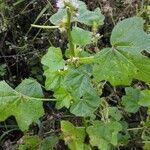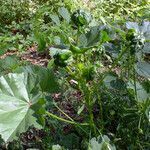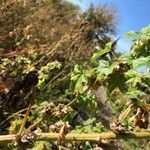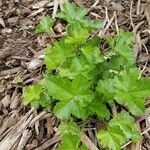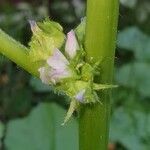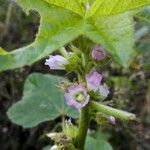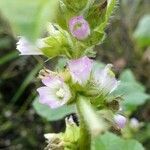Herbs biennial, 50-100(-120) cm tall; stem sparsely stellate velutinous. Stipules ovate-lanceolate, 3-5 × 2-4 mm, stellate puberulent; petiole 2-8(-15) cm, puberulent in adaxial groove, glabrescent; leaf blade reniform or round, (3-)5-11 × (2-)5-11 cm, both surfaces very sparsely strigose or subglabrous, 5-7-lobed, lobes rounded or acute, margin crenate-serrate. Flowers 3-to many-fascicled, axillary. Pedicels 2-15(-40) mm. Epicalyx lobes filiform-lanceolate, (3-)5-6 mm, ciliate. Calyx cup-shaped, 5-8 mm, lobes broadly triangular, sparsely stellate strigose. Corolla whitish to reddish, slightly longer than sepals; petals 6-8 mm, apex retuse; claw glabrous or sparsely hairy. Filament tube 3-4 mm, glabrous or with a few simple hairs. Style branches 10-11. Schizocarp flat-globose, 5-7 mm in diam.; mericarps 10-12, abaxially smooth, ca. 1 mm thick, angles rounded and rugose, sides reticulate. Seeds purple-brown, reniform, ca. 1.5 mm in diam., glabrous. Fl. Mar-Nov.
An erect herb. It takes 1 or 2 years to complete its life cycle. It grows to about 1 m high. The leaves have stalks. The leaves are half round or heart shaped. There are 3-5 lobes. The leaves are 5-11 cm long by 5-11 cm wide. The lobes are rounded and with shallow round teeth. The flowers have short stalks. They are pink or white. They are crowded in the axils of leaves. The fruit is flat and round and 5-7 mm across. The seeds are kidney shaped and 1.5 mm across. They are purple-brown.
Erect annual to 2 m, with large, long-petioled lvs mostly (6–)8–15(–20) cm wide, reniform, with 5–7 rounded, crenate lobes, the upper on progressively shorter petioles; fls subsessile in axillary fascicles; pet 6 mm, white or bluish-white; fr as in no. 6 [Hypericum boreale (Britton) E. P. Bicknell]; 2n=ca 84. Probably native of e. Asia, escaped from cult. here and there in our range. July–Sept. One form has the lvs crisp-margined.
Leaf-lamina 4–11 cm. in diam., of basal leaves reniform, of cauline leaves suborbicular and 5-lobed with rounded lobes on lower ones and those of upper ones triangular, margin crenulate-dentate; petiole 4–8 cm. long, longitudinally sulcate, glabrescent except that the grooves remain tomentose; stipules ovate-lanceolate.
Mericarps 10–12, dorsally smooth or faintly rugose, rugose along the rounded angles, flabellately striate on the flat lateral sides.
Flowers in fascicles; pedicels unequal, the longest up to about 3 cm., shortly stellate-pilose.
Petals about twice as long as the calyx; claw glabrous or with a few weak hairs.
Calyx somewhat inflated, sparsely stellate-hirsute; lobes triangular, acute.
Caule erecto, foliis angulatis, floribus axillaribus glomeratis.
Biennial herb 0·5–1 m. tall; stems shortly stellate-pilose.
Bracts of epicalyx 5–6 mm. long, linear, ciliate.
Staminal tube setose in upper portion.
